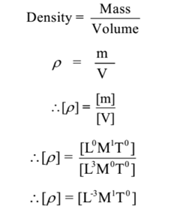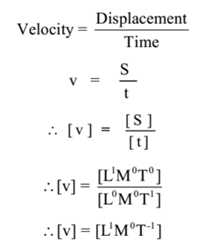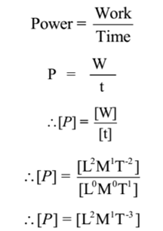Science > Physics > Units and Measurements > Dimensions of Physical Quantities
In this article, we shall study the concept of dimensions of physical quantities and to find dimensions of given physical quantity.
Dimensions of Physical Quantity:
The power to which fundamental units are raised in order to obtain the unit of a physical quantity is called the dimensions of that physical quantity. Dimensions of physical quantity do not depend on the system of units.
If ‘A’ is any physical quantity, then the dimensions of A are represented by [A]. Mass, length and time are represented by M, L, T respectively. Therefore, the dimensions of fundamental quantities are as follows:
- [Mass] = [M]
- [Length] = [L]
- [Time] = [T]
Now electric current (I) and temperature (K) are also considered as fundamental quantities and using them the dimensions of electrical quantities are found. An expression, which gives the relation between the derived units and fundamental units in terms of dimensions is called a dimensional equation. Thus the dimensional equation of speed is[L1M0T-1] and 1, 0, -1 are called dimensions.
Dimensions of Some Physical Quantities:
| Sr.No. | Derived Quantity | Dimensions | S.I. Unit | Symbol |
| 1 | Area | [L2M0T0] | square metre | m2 |
| 2 | Volume | [L3M0T0] | cubic metre | m3 |
| 3 | Density | [L-3M1T0] | kilogram per cubic metre | Kg/m3 |
| 4 | Velocity | [L1M0T-1] | metre per second | m/s |
| 5 | Acceleration | [L1M0T-2] | metre per square second | m/s2 |
| 6 | Momentum | [L1M1T-1] | kilogram metre per second | Kg m/s |
| 7 | Force | [L1M1T-2] | newton | N |
| 8 | Impulse | [L1M1T-1] | newton second | Ns |
| 9 | Work | [L2M1T-2] | joule | J |
| 10 | Kinetic energy | [L2M1T-2] | joule | J |
| 11 | Potential energy | [L2M1T-2] | joule | J |
| 12 | Power | [L2M1T-3] | watt | W |
| 13 | Pressure | [L-1M1T-2] | newton per square metre | N/m2 |
| 14 | Electric charge | [L0M0T1I1] | coulomb | C |
| 15 | Electric current | [L2M1T-3I-1] | ohm | Ω |
| 16 | Electric potential | [L2M1T-3I-2] | volt | V |
Derivation of Dimensions of Some Physical Quantity:
We should know following facts before finding dimensions of other physical quantities.
The dimensions of length (l), breadth (b), height (h), depth (d), thickness (t), width (w), circumference (c), perimeter (p), distance (S), displacement (S), radius (r), diameter (D) are [L1M0T0]
Dimensions of mass are [L0M1T0] and that of time are [L0M0T1].
Dimensions and Unit of Area (A):
Area = Length × Breadth
∴ A = l × b
∴ [A] = [l] × [b]
∴ [A] =[L1M0T0][L1M0T0]
∴ [A] =[L2M0T0]
Dimensions of area are [L2M0T0]
S.I. Unit of the area is square metre (m2). c.g.s. unit of area is square centimetre (cm2)
Dimensions and Unit of Volume (V):
Volume = Length × Breadth × Height
∴ V = l × b × h
∴ [V] = [l] × [b] × [h]
∴ [V] = [L1M0T0][L1M0T0][L1M0T0]
∴ [V] = [L3M0T0]
Dimensions of volume are [L3M0T0]
S.I. Unit of volume is cubic metre (m3). c.g.s. unit of volume is cubic centimetre3 (cm3).
Dimensions and Unit of Density (ρ or d):

Dimensions of density are [L-3M1T0]
S.I. Unit of density is kilogram per cubic metre (kg m3 or kg m-3). c.g.s. unit of density is gram per cubic centimetre (g cm-3)
Dimensions and Unit of Velocity or Speed (v):

Dimensions of velocity or speed are [L1M0T-1]
S.I. Unit of velocity or speed is metre per second (m s-1). c.g.s. unit of velocity or speed is centimetre per second (cm s-1).
Dimensions and Unit of Acceleration (a or f):

Dimensions of acceleration are [L1M0T-2]
S.I. Unit of acceleration is metre per square second (m s-2).
c.g.s. unit of acceleration is centimetre per square second (cm s-2).
Dimensions and Unit of Force (F):
Force = Mass × Acceleration
∴ F = m× a
∴ [F] = [m] × [a]
∴ [F] = [L0M1T0][L1M0T-2]
∴ [F] = [L1M1T-2]
Dimensions of force are [L1M1T-2]
S.I. Unit of force is kilogram metre per square second (kg m s-2), This unit is known as newton (N).
c.g.s. unit of acceleration is gram centimetre per square second (g cm s-2). This unit is known as dyne.
Dimensions and Unit of Momentum (p):
Momentum = Mass × Velocity
∴ p = m× v
∴ [p] = [m] × [v]
∴ [p] = [L0M1T0][L1M0T-1]
∴ [p] = [L1M1T-1]
Dimensions of momentum are [L1M1T-1]
S.I. Unit of momentum is kilogram meter per second (kg m s-1).
c.g.s. unit of momentum is gram centimeter per second (g cm s-1)
Dimensions and Unit of Impulse of Force (J):
Impulse of Force = Force × Time
∴ J =F× t
∴ [J] = [F] × [t]
∴ [J] = [L1M1T-2][L0M0T1]
∴ [J] = [L1M1T-1]
Dimensions of impulse of force are [L1M1T-1]
S.I. Unit of impulse of force is kilogram meter per second (kg m s-1). Common S.I. unit used is newton second (N s).. c.g.s. unit of impulse of force is gram centimeter per second (g cm s-1). Common c.g.s. unit is dyne second.
Dimensions and Unit of Work (W):
Work Done = Force × Displacement
∴ W =F× s
∴ [W] = [F] × [s]
∴ [W] = [L1M1T-2][L1M0T0]
∴ [W] = [L2M1T-2]
Dimensions of work are [L2M1T-2]
S.I. Unit of work is kg square metre per square second. Commonly this unit is known as joule (J).
c.g.s. Unit of work is gram square centimetre per square second. Commonly this unit is known as erg.
Dimensions and Unit of Potential Energy (E or U):
Potential Energy = Mass × Acceleration due to gravity × Height
∴ E =m× g × h
∴ [E] = [m] × [g] × [h]
∴ [E] = [L0M1T0][L1M0T-2][L1M0T0]
∴ [E] = [L2M1T-2]
Dimensions of potential energy are [L2M1T-2]
S.I. Unit of potential energy is kg square metre per square second. Commonly this unit is known as joule (J).
c.g.s. Unit of potential energy is gram square centimetre per square second. Commonly this unit is known as erg.
Dimensions and Unit of Kinetic Energy (E):
Kinetic Energy = 1/2 Mass × Velocity²
∴ E =1/2×m ×v²
∴ [E] = [m] × [v]²
∴ [E] = [L0M1T0][L1M0T-1]²
∴ [E] = [L0M1T0][L2M0T-2]
∴ [E] = [L2M1T-2]
Dimensions of kinetic energy are [L2M1T-2]
S.I. Unit of kinetic energy is kg square metre per square second. Commonly this unit is known as joule (J).
c.g.s. Unit of kinetic energy is gram square centimetre per square second. Commonly this unit is known as erg.
Dimensions and Unit of Pressure (P):

Dimensions of Pressure are [L-1M1T-2] S.I. Unit of pressure is
S.I. Unit of pressure is newton per square metre or pascal (N m-2 or Pa).
c.g.s. unit of pressure is dyne per square centimetre (dyne cm-2)
Dimensions and Unit of Power (P):

Dimensions of Power are [L2M1T-3]
S.I. Unit of Power is watt (W). c.g.s. unit of power is erg per second (erg s-1)
Dimensions and Unit of Electric Charge:
Electric Charge = Electric Current × Time
∴ Q =I× t
∴ [Q] = [I] × [t]
∴ [Q] = [L0M0T0I1][L0M0T1]
∴ [Q] = [L0M0T1I1]
Dimensions of electric charge are [L0M0T1I1]
S.I. Unit of electric charge is coulomb (C)
Dimensions and Unit of Electric Potential:

Dimensions of electric potential are [L2M1T-3I-1]
S.I. Unit of electric potential is volt (V)
Dimensions and Unit of Electric Resistance:

Dimensions of electric resistance are [L2M1T-3I-2]
S.I. Unit of electric resistance is ohm (Ω)
Previous Topic: Measurement of Time
Next Topic: Applications of Dimensional Analysis

63 replies on “Dimensions of Physical Quantities”
It really helped me a lot.
WOW.
This is really helpful.
Thanks.
Thanks it is Very helpful
Thank you so much, this really helped a lot
Thanks it helped me a lot
Wow thank you it’s really helpful
Muah😘
Tanks dis was really helpful
Helpful
It is very helpful
Well done . your expressions are so encouraging. Keep the spirit.
It is a very helpful
This is more detailed than a textbook
It was supernatural helpful in waec
I am still confused oooooo
Help!!!
Shortly we are adding a video for this topic.
Better 😀
It is very helpful
Nice work👍👍
Well explained.
Thanks, it’s helpful
Very good to me
Too easy to understand.
Nice one
It’s very helpful 👍
yes it’s very helpful
Very helpful
Thanks
OMG it’s awesome I never get this link before I shared it to all of my friends
It’s helpful thanku so much ❤️😒
EXCEPTIONAL.
Very helpful
Helpful
Very much explainable😇
Very helpful
this is veryy full !!
It really aided me with understanding this dimension stuff. I bet this site is a surety for every student.
Simply to understand .I like it 👌
So much informative. Really so much appreciable for this great work.😊👍🏻
Very lovely explanation
it is a very detailed, easy and, well-organized form with all formulas of dimensions
Thanks a lot
It’s very important and helpful for physics………………………
it was helpful but i didn’t get the dimensions and unit of pressure
Just go through the article, dimensions and unit of pressure are derived.
It’s given in the individual section of pressure
Well explained and well understanding.
It is very help full
Thank you
Thanks so much😊
I love your explanations
It really helped me alot
Thanks
This is very helpful
I really a good one.
EXCELLENT. WRITTEN IN LUCID WAY. THANK YOU
THANK YOU. EXPLAINED IN EASY TO GRASP
It’s very easy to understand.
Thank u
Thanks 😊 and God bless
wow i really love these, it was very helpful…
Thank you very much , you are superb👌👌👌👌👌👌👌👌👌👌👌.
Thanks a lot
I grabbed a thing or two
it’s helping me in my education
Wow this is helpful
Thanks for the aid
I really gain a lot from this and it’s helping me.
thanks so much, it really help me alot